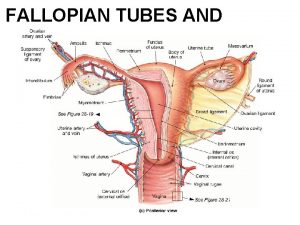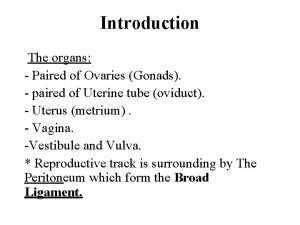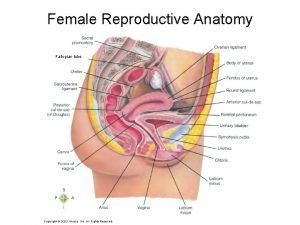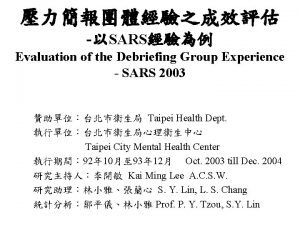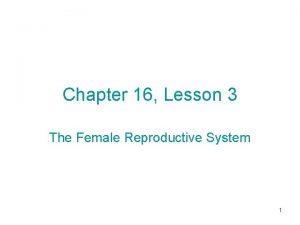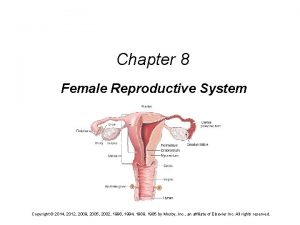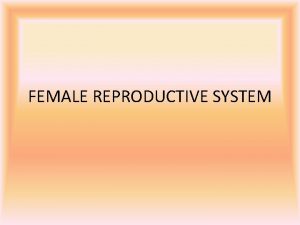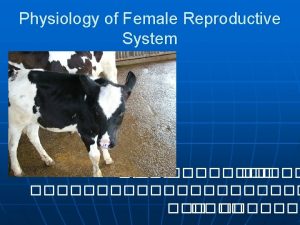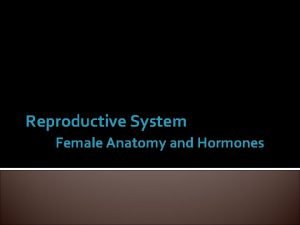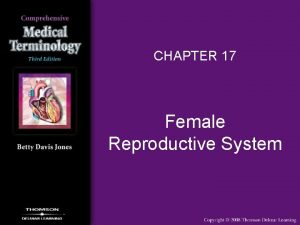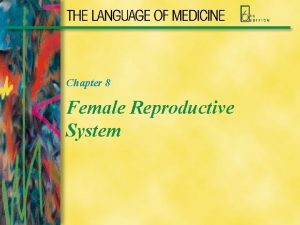Reproductive System Cont Female Anatomy Physiology Chapter 28









- Slides: 9

Reproductive System Cont. Female Anatomy & Physiology Chapter 28

FEMALE ANATOMY • Ovaries = produce eggs • Ovarian follicles = contain eggs in various stages of development and the cells that surround them; surrounding cells nourish the eggs & produce estrogen • Corpus luteum = remnants of a mature follicle after ovulation (after egg is released); produces estrogen, progesterone, and relaxin

• Uterine tubes (oviducts/fallopian tubes) = transport eggs from the ovary to the uterus; fertilization occurs in the oviducts • Uterus = organ in which the fetus develops • Endometrium = uterine lining • Cervix = lower end of uterus • Vagina = passageway between the uterus and the outside • Vulva = external genitals of the female

Female Reproductive Cycles: 1. Ovarian Cycle & 2. Menstrual (Uterine) Cycle

Female Reproductive Cycles Female reproductive cycles prepare the female body for pregnancy 1. Ovarian cycle = cyclic events that occur in the ovaries 2. Menstrual (uterine) cycle = cyclic events that occur in the uterus • Last 28 days on average • Influenced by 1. hormones secreted by pituitary gland: FSH and LH 2. hormones secreted by ovary: estrogen and progesterone

OVARIAN CYCLE 1. Follicular phase – prior to ovulation: • One ovarian follicle becomes the dominant follicle and begins to mature when the pituitary gland releases FSH • Maturing follicle releases estrogen and causes the pituitary gland to release LH (this is an example of positive feedback: an increase in one hormone results in increase of another hormone) 2. Ovulation (day 14): • levels of LH reach its peak and initiate ovulation • Ovulation = egg is released from the dominant follicle 3. Luteal phase – after ovulation: • Ruptured follicle becomes corpus luteum and secretes estrogen and progesterone • High levels of estrogen and progesterone inhibit FSH and LH (this is an example of negative feedback: increase in one hormone results in decrease of another hormone)

MENSTRUAL CYCLE • If the egg does not become fertilized, levels of estrogen and progesterone fall and cause endometrium to be shed = menstrual flow or menstruation (days 1 -5) • Starting with day 6, increasing levels of estrogen cause endometrium to thicken and prepare uterus for possible implantation of fertilized egg

FERTILIZATION • Fertilization = union of sperm and egg; the resulting cell is called zygote • Takes place in the uterine tube

IMPLENTATION • Implentation = the zygote passes into the uterus where it attaches into the uterine lining (by the sixth day after fertilization)


